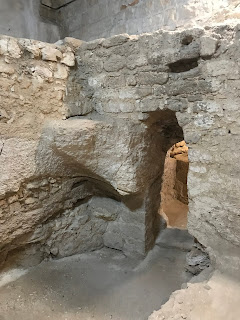 |
| The altar at Beth-Phage |
Note: I just got a few pictures to download and will post the most pertinent ones.
Today was yet another very full, intensely emotional day. We started out in the Garden of Gethsemane which was so deeply moving. We chanted the Taize "Stay with me, remain here with me, watch and pray. Watch and pray." I couldn't finish singing it for the lump in my throat. It's an emotional chant anyway, but chanting it there, in the Garden, was just too powerful for words.
 |
| Jesus weeps the first time over Jerusalem |
The church there is designed like a teardrop and the altar has a beautiful mosaic of a mother head trying to gather up her chicks under her wing.
I wish I could show you the pictures I took of the Caiaphas Palace, now known as St. Peter in Calicantu ("crowing rooster"). It was there that Jesus was thrown into The Pit.
I had no idea that Jesus was lowered down through a hole in the ceiling into The Pit. It doesn't say that in scriptures but it's pretty clear that this is what happened to prisoners at that time and in that place.
We joined another church group that was there who started singing "Alleluia" and "How Great Thou Art" in at least four-part harmony while we were in that pit. The beauty and the poignancy just about did me in.
We'll continue the journey tomorrow morning at 5:45 AM when we walk the Via Dolorosa ("The Way of Sorrows" using John Peterson's meditations on the Stations of the Cross. We'll also go to Emmaus and then have a free afternoon before we get ready to take our leave for the airport.
We did make a brief stopover to visit an amazing place known as "Princess Basma Center for Disabled Children on the Mount of Olives". The Center is home to those who suffer with many types of birth trauma or deformity, debilitating injuries, autism, and other physical and emotional needs.
There is a new live-in unit for mothers and their children where mothers learn the physical therapy techniques they need for the child to function at an optimum level. That unit can hold 24 mothers and children. The day school numbers 450 and is fully integrated.
We visited one classroom of first graders who sang, "Twinkle, Twinkle, Little Star" - in English. I don't think I'm ever going to be able to hear that song again the same way. Every.
We also visited a workshop where older teens and adults learn to make tables and chairs and various woodwork and tile which is sold and raises money to continue to keep this project sustainable.
I encourage you to click on the link here or above and check it out. It was wonderful to see so many Episcopal Dioceses and individual churches supporting this important work with generous donations.
We had a lovely lunch at the Jerico home of our guide where we exchanged meaningful gifts with our prayer partner on this pilgrimage (more on that later) and then it was off to the Dead Sea where the water was warm enough to swim in and even those who can't swim were able to float like a cork.
Folks slathered the black mud on their bodies, letting it cake on and then they washed it off in the showers provided. We were repeatedly cautioned not to swim face down or get the water in our eyes or in our mouths.
Of course, you no doubt know that the reason the Dead Sea is dead is that water flows into it from the mountains and underground aquifers and springs but it does not send it on.
It receives but does not give. And so, it is dead.
Powerful metaphor, right there in nature.
I'm too exhausted tonight for any other profound thoughts, so I'll leave you with that.
I'll have more time to reflect and write after we leave here tomorrow.
For now, all I can say is that I can not only feel the transformation in my own soul, I see it on the faces of my fellow pilgrims.
I wish you all could be here to experience it for yourselves, but if this has helped one of you to get a vicarious bit of an insight into The Holy Land, I'll be delighted.














































